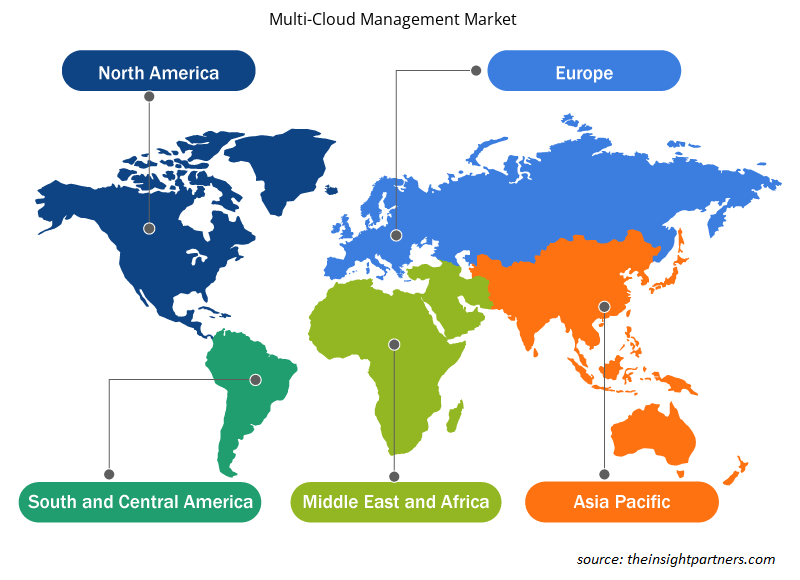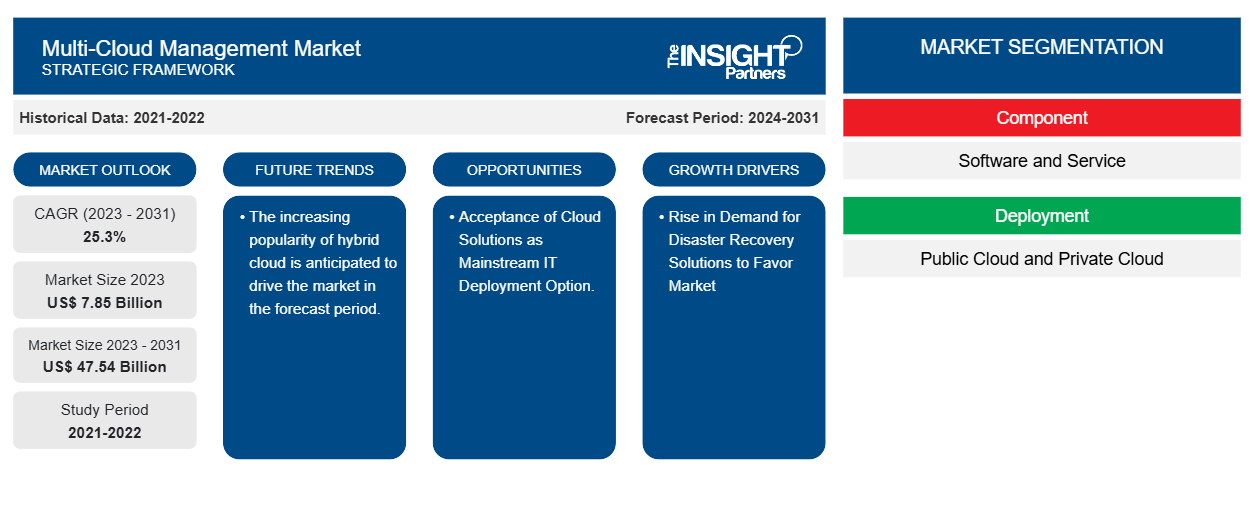من المتوقع أن يصل حجم سوق إدارة السحابة المتعددة إلى 47.54 مليار دولار أمريكي بحلول عام 2031 من 7.85 مليار دولار أمريكي في عام 2023. ومن المتوقع أن يسجل السوق معدل نمو سنوي مركب بنسبة 25.3٪ خلال الفترة 2023-2031. من المرجح أن تكون الزيادة في الحاجة إلى تجنب حبس البائعين هي الاتجاهات الرئيسية والدوافع لسوق إدارة السحابة المتعددة. يشير حبس البائعين إلى الموقف الذي تختار فيه المؤسسة نقل أعمالها من بائعيها الحاليين ولكنها لا تستطيع القيام بذلك لأسباب عديدة، مثل التكلفة المتوقعة ومدة وتعقيد التبديل وارتفاع الطلب على حلول استرداد الكوارث.
تحليل سوق إدارة السحابة المتعددة
يشهد سوق إدارة السحابة المتعددة نموًا كبيرًا على مستوى العالم. ويعزى هذا النمو إلى الارتفاع في الحاجة إلى تجنب الاستحواذ على البائعين وارتفاع الطلب على حلول استرداد الكوارث. وعلاوة على ذلك، من المتوقع أن تؤدي الشعبية المتزايدة للسحابة الهجينة وزيادة توليد البيانات وارتفاع استخدام الأجهزة الشخصية (BYOD) واختيار الأجهزة (CYOD) إلى دفع السوق في السنوات القادمة.
نظرة عامة على سوق إدارة السحابة المتعددة
تعتبر إدارة السحابة المتعددة مجموعة من الأدوات والإجراءات التي تمكن الشركة من تأمين ومراقبة التطبيقات وأحمال العمل عبر سحابات عامة متعددة. يتيح حل إدارة السحابة المتعددة لفرق تكنولوجيا المعلومات إدارة سحابات متعددة من واجهة واحدة ويدعم منصات سحابية متعددة مثل Azure وAWS.
قم بتخصيص هذا التقرير ليناسب متطلباتك
ستحصل على تخصيص لأي تقرير - مجانًا - بما في ذلك أجزاء من هذا التقرير، أو تحليل على مستوى الدولة، وحزمة بيانات Excel، بالإضافة إلى الاستفادة من العروض والخصومات الرائعة للشركات الناشئة والجامعات
- احصل على أهم اتجاهات السوق الرئيسية لهذا التقرير.ستتضمن هذه العينة المجانية تحليلاً للبيانات، بدءًا من اتجاهات السوق وحتى التقديرات والتوقعات.
محركات وفرص سوق إدارة السحابة المتعددة
ارتفاع الطلب على حلول التعافي من الكوارث لصالح السوق
يعد استرداد الكوارث جانبًا بالغ الأهمية في أي نشر سحابي. وفقًا لإحصائيات يوم النسخ الاحتياطي العالمي، يتعرض 10% من أجهزة الكمبيوتر لهجوم من الفيروسات كل شهر، ولا يقوم 30% من الأشخاص بنسخ بياناتهم احتياطيًا على الإطلاق. علاوة على ذلك، فإن الحوادث، بما في ذلك قيام أعضاء الموظفين بمسح البيانات التي لم يتم نسخها احتياطيًا في مكان آخر، تمثل 29% من الكوارث. علاوة على ذلك، تشارك العديد من الشركات في السوق في تقديم حلول استرداد الكوارث. على سبيل المثال، يتيح حل استرداد الكوارث متعدد السحابات المستمر للمؤسسات تحقيق تنقل التطبيقات وحماية البيانات دون أي قيود لتحقيق مقاومة الأعمال. يمكن لمديري تكنولوجيا المعلومات حماية كل تطبيق ونظام تشغيل وحاوية وقاعدة بيانات وبيانات وما إلى ذلك بأمان وسرعة، في بنية تحتية هجينة ومتعددة السحابات.
قبول حلول الحوسبة السحابية كخيار رئيسي لنشر تكنولوجيا المعلومات.
تقبل أغلب الشركات على مستوى العالم خدمات الحوسبة السحابية كنموذج قابل للتطبيق لنشر تكنولوجيا المعلومات. ولا يزال السبب الأكثر شيوعًا لتبني الحوسبة السحابية هو مرونة وأمان البيانات في الحوسبة السحابية كمنصة توصيل. وقد انتقلت العديد من الشركات إلى خدمة سحابية واحدة أو أكثر، مما أثر على الشركات الأخرى لتبني الحوسبة السحابية للحصول على ميزة تنافسية. تُعرف الحوسبة السحابية حاليًا بأنها نموذج نشر موثوق به في سياق استراتيجية تكنولوجيا المعلومات الخاصة بالمؤسسة، مع بقاء مستويات الرضا مرتفعة ويتوقع ثلثا المستخدمين النهائيين على مستوى العالم الذين يستخدمون خدمة سحابية اليوم توسيع نطاق عملهم خلال العام المقبل.
تقرير تحليل تجزئة سوق إدارة السحابة المتعددة
إن القطاعات الرئيسية التي ساهمت في استخلاص تحليل سوق إدارة السحابة المتعددة هي المكونات والنشر والتطبيق والقطاعات الرأسية.
- بناءً على المكون، ينقسم سوق إدارة السحابة المتعددة إلى برمجيات وخدمات. ومن المتوقع أن يحظى قطاع البرمجيات بحصة سوقية كبيرة خلال فترة التوقعات.
- بناءً على النشر، ينقسم سوق إدارة السحابة المتعددة إلى سحابة عامة وسحابة خاصة. ومن المتوقع أن تحظى شريحة السحابة العامة بحصة سوقية كبيرة خلال فترة التوقعات.
- من حيث التطبيق، يتم تقسيم السوق إلى إدارة البنية التحتية والموارد، وإدارة الهوية والسياسات، وإدارة الامتثال، والقياس والفوترة، والتزويد وإدارة دورة الحياة. ومن المتوقع أن يستحوذ قطاع إدارة البنية التحتية والموارد على حصة سوقية كبيرة في الفترة المتوقعة.lifecycle management. The infrastructure and resource management segment is anticipated to hold a significant market share in the forecast period.
- بحسب القطاعات، يتم تقسيم السوق إلى تكنولوجيا المعلومات والاتصالات، والخدمات المصرفية والمالية والتأمين، والحكومة، وتجارة التجزئة والسلع الاستهلاكية، والسفر والضيافة، والرعاية الصحية وعلوم الحياة، وغيرها. ومن المتوقع أن يستحوذ قطاع تكنولوجيا المعلومات والاتصالات على حصة سوقية كبيرة في الفترة المتوقعة.BFSI, government, retail and consumer goods, travel and hospitality, healthcare and life science, and others. The IT and telecom segment is anticipated to hold a significant market share in the forecast period.
تحليل حصة سوق إدارة السحابة المتعددة حسب المنطقة الجغرافية
ينقسم النطاق الجغرافي لتقرير سوق إدارة السحابة المتعددة بشكل أساسي إلى خمس مناطق: أمريكا الشمالية، ومنطقة آسيا والمحيط الهادئ، وأوروبا، والشرق الأوسط وأفريقيا، وأمريكا الجنوبية والوسطى.
سيطرت أمريكا الشمالية على سوق إدارة السحابة المتعددة. ويعزى الارتفاع في سوق إدارة السحابة المتعددة في أمريكا الشمالية بشكل أساسي إلى الزيادة الكبيرة في البيانات، والاعتماد المتزايد على إنترنت الأشياء والبنية التحتية السحابية، والطفرة في بناء مراكز البيانات. تعد الحوسبة السحابية اتجاهًا رئيسيًا في جميع المؤسسات في أمريكا الشمالية. أصبحت السحابة بسرعة هي القاعدة الجديدة للشركات في الولايات المتحدة وكندا. علاوة على ذلك، فإن التركيز القوي على البحث والتطوير في الاقتصادات المتقدمة في الولايات المتحدة وكندا يجبر اللاعبين في أمريكا الشمالية على جلب حلول متقدمة تقنيًا إلى السوق. بالإضافة إلى ذلك، يوجد في الولايات المتحدة عدد كبير من اللاعبين في سوق إدارة السحابة المتعددة الذين يركزون بشكل متزايد على تطوير حلول مبتكرة. تساهم كل هذه العوامل في نمو سوق إدارة السحابة المتعددة في المنطقة.
رؤى إقليمية حول سوق إدارة السحابة المتعددة
لقد قام المحللون في Insight Partners بشرح الاتجاهات والعوامل الإقليمية المؤثرة على سوق إدارة السحابة المتعددة طوال فترة التوقعات بشكل شامل. يناقش هذا القسم أيضًا قطاعات سوق إدارة السحابة المتعددة والجغرافيا في جميع أنحاء أمريكا الشمالية وأوروبا ومنطقة آسيا والمحيط الهادئ والشرق الأوسط وأفريقيا وأمريكا الجنوبية والوسطى.

- احصل على البيانات الإقليمية المحددة لسوق إدارة السحابة المتعددة
نطاق تقرير سوق إدارة السحابة المتعددة
| سمة التقرير | تفاصيل |
|---|---|
| حجم السوق في عام 2023 | 7.85 مليار دولار أمريكي |
| حجم السوق بحلول عام 2031 | 47.54 مليار دولار أمريكي |
| معدل النمو السنوي المركب العالمي (2023 - 2031) | 25.3% |
| البيانات التاريخية | 2021-2022 |
| فترة التنبؤ | 2024-2031 |
| القطاعات المغطاة | حسب المكون
|
| المناطق والدول المغطاة | أمريكا الشمالية
|
| قادة السوق وملفات تعريف الشركات الرئيسية |
|
كثافة اللاعبين في سوق إدارة السحابة المتعددة: فهم تأثيرها على ديناميكيات الأعمال
يشهد سوق إدارة السحابة المتعددة نموًا سريعًا، مدفوعًا بالطلب المتزايد من المستخدم النهائي بسبب عوامل مثل تفضيلات المستهلك المتطورة والتقدم التكنولوجي والوعي المتزايد بفوائد المنتج. ومع ارتفاع الطلب، تعمل الشركات على توسيع عروضها والابتكار لتلبية احتياجات المستهلكين والاستفادة من الاتجاهات الناشئة، مما يؤدي إلى زيادة نمو السوق.
تشير كثافة اللاعبين في السوق إلى توزيع الشركات أو المؤسسات العاملة في سوق أو صناعة معينة. وهي تشير إلى عدد المنافسين (اللاعبين في السوق) الموجودين في مساحة سوق معينة نسبة إلى حجمها أو قيمتها السوقية الإجمالية.
الشركات الرئيسية العاملة في سوق إدارة السحابة المتعددة هي:
- شركة BMC للبرمجيات
- شركة سيسكو سيستمز
- فليكسيرا
- شركة الآلات التجارية الدولية
- شركة مايكرو فوكس الدولية المحدودة
- شركة زرتو المحدودة
إخلاء المسؤولية : الشركات المذكورة أعلاه ليست مرتبة بأي ترتيب معين.

- احصل على نظرة عامة على أهم اللاعبين الرئيسيين في سوق إدارة السحابة المتعددة
أخبار سوق إدارة السحابة المتعددة والتطورات الأخيرة
يتم تقييم سوق إدارة السحابة المتعددة من خلال جمع البيانات النوعية والكمية بعد البحث الأولي والثانوي، والذي يتضمن منشورات الشركات المهمة وبيانات الجمعيات وقواعد البيانات. فيما يلي بعض التطورات في سوق إدارة السحابة المتعددة:
- أعلنت شركة Oracle وGoogle Cloud عن شراكة تتيح للعملاء اختيار الجمع بين تقنيات Oracle Cloud Infrastructure (OCI) وGoogle Cloud للمساعدة في تسريع عمليات نقل التطبيقات وتحديثها. (المصدر: Oracle، موقع الشركة، يونيو 2024)
- أعلنت شركة Verizon Business عن إدارة السحابة عبر خدمة Network as a Service (NaaS)، وهي خدمة جديدة تتيح للشركات التحكم في مكونات التطبيق وهندسة الشبكة عبر بيئات سحابية متعددة - عامة وخاصة وهجينة، في بوابة موحدة عبر الإنترنت. (المصدر: موقع الشركة على الويب، فبراير 2024)
تقرير سوق إدارة السحابة المتعددة: التغطية والنتائج المتوقعة
يوفر تقرير "حجم سوق إدارة السحابة المتعددة والتوقعات (2021-2031)" تحليلاً مفصلاً للسوق يغطي المجالات التالية:
- حجم سوق إدارة السحابة المتعددة وتوقعاته على المستويات العالمية والإقليمية والوطنية لجميع قطاعات السوق الرئيسية المشمولة بالنطاق.
- اتجاهات سوق إدارة السحابة المتعددة بالإضافة إلى ديناميكيات السوق مثل المحركات والقيود والفرص الرئيسية.
- تحليل مفصل لقوى PEST/Porter الخمس و SWOT.
- تحليل سوق إدارة السحابة المتعددة يغطي اتجاهات السوق الرئيسية والإطار العالمي والإقليمي واللاعبين الرئيسيين واللوائح والتطورات الأخيرة في السوق.
- تحليل المشهد الصناعي والمنافسة الذي يغطي تركيز السوق، وتحليل خريطة الحرارة، واللاعبين البارزين، والتطورات الأخيرة لسوق إدارة السحابة المتعددة.
- ملفات تعريفية مفصلة للشركة.
- التحليل التاريخي (سنتان)، سنة الأساس، التوقعات (7 سنوات) مع معدل النمو السنوي المركب
- تحليل PEST و SWOT
- حجم السوق والقيمة / الحجم - عالمي، إقليمي، بلد
- الصناعة والمنافسة
- مجموعة بيانات إكسل
التقارير الحديثة
تقارير ذات صلة
شهادات العملاء
سبب الشراء
- اتخاذ قرارات مدروسة
- فهم ديناميكيات السوق
- تحليل المنافسة
- رؤى العملاء
- توقعات السوق
- تخفيف المخاطر
- التخطيط الاستراتيجي
- مبررات الاستثمار
- تحديد الأسواق الناشئة
- تحسين استراتيجيات التسويق
- تعزيز الكفاءة التشغيلية
- مواكبة التوجهات التنظيمية























 احصل على عينة مجانية ل - سوق إدارة السحابة المتعددة
احصل على عينة مجانية ل - سوق إدارة السحابة المتعددة